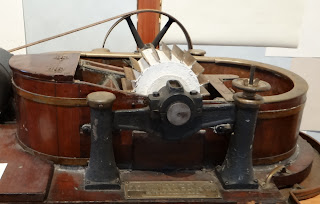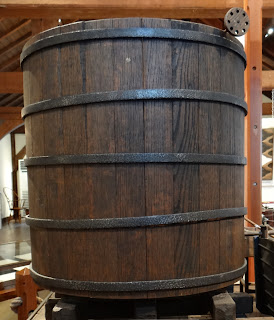Later, Crane's son moved west to Dalton Massachussets to open his own paper company. So a visit to the Crane Museum was on my list of things to see while we were in the Berkshires. The museum features scale models to show each of the steps that were involved in making paper in the 19th century.
 In 1801, when Zenas Crane launched Crane and Company, almost all of the fiber used for paper came from discarded cotton and linen rags. So the first step in paper making is collecting and sorting the rags.
In 1801, when Zenas Crane launched Crane and Company, almost all of the fiber used for paper came from discarded cotton and linen rags. So the first step in paper making is collecting and sorting the rags. This is a scale model of a Hollander Beater. The beater would tear apart the rags and break them down into individual cotton or linen fibers.
This is a scale model of a Hollander Beater. The beater would tear apart the rags and break them down into individual cotton or linen fibers. The fibers are mixed with water and additives to form a slurry of rag pulp. The tanks where the mixing takes place are called chests.
The fibers are mixed with water and additives to form a slurry of rag pulp. The tanks where the mixing takes place are called chests. The Vatman dips his mould, a framed wire screen, into a vat of pulp. He lifts the mould out of the pulp and shakes it to drain off excess water. The pulp that remains in the screen forms a moist sheet of paper.
The Vatman dips his mould, a framed wire screen, into a vat of pulp. He lifts the mould out of the pulp and shakes it to drain off excess water. The pulp that remains in the screen forms a moist sheet of paper. The Coucher turns the mould over so the damp sheet of paper adheres to a piece of wool felt. He returns the mould to the Vatman.
The Coucher turns the mould over so the damp sheet of paper adheres to a piece of wool felt. He returns the mould to the Vatman. The Layboy separates the sheets from the felt and stacks the paper into sets of 144, a quantity referred to as a "post."
The Layboy separates the sheets from the felt and stacks the paper into sets of 144, a quantity referred to as a "post."Today, paper is made in rolls on machines that do these same steps in a continuous process. The paper is cut into sheets afterward.
You might also like:
17+17>34
Print Can Be Art
Finish Before You Start


Yes, you are right. It is so delightful to remember the role paper played in the American Revolution. The history of paper is not too old but it has taken an important role in our lives. To make certain things tangible, we have to use paper. One of the great uses of paper is to print books. Before the internet, the spread of knowledge was not possible without books. Book fulfillment, which means to deliver books to online buyers, also requires some paperwork.
ReplyDeleteAfter our visit to the museum, my wife wanted to make some paper herself. So I built her a makeshift beater and some screens. It worked, but it is a tedious process.
Delete